A Probabilistic Model for Real-Time Semantic Prediction of Human Motion Intentions from RGBD-Data
Abstract
:1. Introduction
2. Related Work
- posing an abstract semantic model for human intentions that encloses all probable walking paths to predefined semantic goals,
- evaluating the model as human walking hypotheses.
3. Methodology
3.1. Definition of the Hypotheses on a Human’s Navigation Goals
- All (semantic) directions that lead to an alternative route such as left, straight and right on a crossing or an object of interest such a person or a locker (one hypothesis for each direction based on the position of the person inducing different directions of movement);
- The alternatives in the direct neighborhood of the robot, namely;
- (a)
- Passing of the robot either on the left side or on the right side (two hypotheses leading to different directions of movement);
- (b)
- The collision with the area required for navigation of the system (single hypothesis with a movement directed towards the robot);
- A standstill of the person (single hypothesis with zero velocity);
- Undefined Goal, i.e., not 1–3 (single hypothesis when there is no evidence for the alternative movement directions).
3.2. Linking Semantic Maps to the Hypotheses
3.3. Evaluation of the Hypotheses
4. Experiments and Discussion
4.1. Experiment 1: Single Crossing
4.1.1. Experiment 1.1: Human Passing a Robot
4.1.2. Experiment 1.2: Collision Course
4.1.3. Experiment 1.3: Standstill
4.1.4. Experiment 1.4: Indecisive Person
4.1.5. Experiment 1.5: Various Persons
4.2. Experiment 2: Online Adaptation
4.3. Experiment 3: Dynamic Situation
5. Conclusions & Recommendations
Author Contributions
Funding
Institutional Review Board Statement
Informed Consent Statement
Data Availability Statement
Acknowledgments
Conflicts of Interest
Abbreviations
| AGV | Automated Guided Vehicle |
| UG | Undefined Goal |
References
- Triebel, R.; Arras, K.; Alami, R.; Beyer, L.; Breuers, S.; Chatila, R.; Chetouani, M.; Cremers, D.; Evers, V.; Fiore, M.; et al. SPENCER: A socially aware service robot for passenger guidance and help in busy airports. Springer Tracts Adv. Robot. 2016, 113, 607–622. [Google Scholar] [CrossRef] [Green Version]
- ROPOD-Consortium. ROPOD. Available online: http://ropod.org/ (accessed on 14 May 2021).
- ILIAD. Available online: http://iliad-project.eu/ (accessed on 14 May 2021).
- González, D.; Pérez, J.; Milanés, V.; Nashashibi, F. A Review of Motion Planning Techniques for Automated Vehicles. IEEE Trans. Intell. Transp. Syst. 2016, 17, 1135–1145. [Google Scholar] [CrossRef]
- Kruse, T.; Pandey, A.K.; Alami, R.; Kirsch, A. Human-aware robot navigation: A survey. Robot. Auton. Syst. 2013, 61, 1726–1743. [Google Scholar] [CrossRef] [Green Version]
- Muhammad, N.; Åstrand, B. Intention Estimation Using Set of Reference Trajectories as Behaviour Model. Sensors 2018, 18, 4423. [Google Scholar] [CrossRef] [PubMed] [Green Version]
- Kitani, K.M.; Ziebart, B.D.; Bagnell, J.A.; Hebert, M. Activity Forecasting. In Computer Vision—ECCV 2012; Fitzgibbon, A., Lazebnik, S., Perona, P., Sato, Y., Schmid, C., Eds.; Springer: Berlin/Heidelberg, Germany, 2012; pp. 201–214. [Google Scholar]
- Neumany, B.; Likhachevy, M. Planning with approximate preferences and its application to disambiguating human intentions in navigation. In Proceedings of the 2013 IEEE International Conference on Robotics and Automation, Karlsruhe, Germany, 6–10 May 2013; pp. 415–422. [Google Scholar]
- Durdu, A.; Erkmen, I.; Erkmen, A. Estimating and reshaping human intention via human–robot interaction. Turk. J. Electr. Eng. Comput. Sci. 2016, 24, 88–104. [Google Scholar] [CrossRef]
- Vasquez, D.; Fraichard, T.; Laugier, C. Growing Hidden Markov Models: An Incremental Tool for Learning and Predicting Human and Vehicle Motion. Int. J. Robot. Res. 2009, 28, 1486–1506. [Google Scholar] [CrossRef] [Green Version]
- Elfring, J.; van de Molengraft, R.; Steinbuch, M. Learning intentions for improved human motion prediction. Robot. Auton. Syst. 2014, 62, 591–602. [Google Scholar] [CrossRef]
- Schneider, N.; Gavrila, D.M. Pedestrian Path Prediction with Recursive Bayesian Filters: A Comparative Study. In Pattern Recognition; Weickert, J., Hein, M., Schiele, B., Eds.; Springer: Berlin/Heidelberg, Germany, 2013; pp. 174–183. [Google Scholar] [CrossRef] [Green Version]
- Lefèvre, S.; Vasquez, D.; Laugier, C. A survey on motion prediction and risk assessment for intelligent vehicles. Robomech J. 2014, 1, 1. [Google Scholar] [CrossRef] [Green Version]
- Neggers, M.M.E.; Cuijpers, R.H.; Ruijten, P.A.M. Comfortable Passing Distances for Robots. In Social Robotics; Ge, S.S., Cabibihan, J.J., Salichs, M.A., Broadbent, E., He, H., Wagner, A.R., Castro-González, Á., Eds.; Springer International Publishing: Cham, Switzerland, 2018; pp. 431–440. [Google Scholar]
- Ratsamee, P.; Mae, Y.; Ohara, K.; Kojima, M.; Arai, T. Social navigation model based on human intention analysis using face orientation. In Proceedings of the 2013 IEEE/RSJ International Conference on Intelligent Robots and Systems, Tokyo, Japan, 3–7 November 2013; pp. 1682–1687. [Google Scholar]
- Kivrak, H.; Cakmak, F.; Kose, H.; Yavuz, S. Social navigation framework for assistive robots in human inhabited unknown environments. Eng. Sci. Technol. Int. J. 2021, 24, 284–298. [Google Scholar] [CrossRef]
- Peddi, R.; Franco, C.D.; Gao, S.; Bezzo, N. A Data-driven Framework for Proactive Intention-Aware Motion Planning of a Robot in a Human Environment. In Proceedings of the 2020 IEEE/RSJ International Conference on Intelligent Robots and Systems (IROS), Las Vegas, NV, USA, 24 October 2020–24 January 2021; pp. 5738–5744. [Google Scholar] [CrossRef]
- Vasquez, D.; Stein, P.; Rios-Martinez, J.; Escobedo, A.; Spalanzani, A.; Laugier, C. Human Aware Navigation for Assistive Robotics. In Experimental Robotics: The 13th International Symposium on Experimental Robotics; Springer International Publishing: Berlin/Heidelberg, Germany, 2013; pp. 449–462. [Google Scholar] [CrossRef] [Green Version]
- Kostavelis, I.; Kargakos, A.; Giakoumis, D.; Tzovaras, D. Robot’s Workspace Enhancement with Dynamic Human Presence for Socially-Aware Navigation; Computer Vision Systems; Liu, M., Chen, H., Vincze, M., Eds.; Springer International Publishing: Cham, Switzerland, 2017; pp. 279–288. [Google Scholar]
- Rios-Martinez, J.; Spalanzani, A.; Laugier, C. From Proxemics Theory to Socially-Aware Navigation: A Survey. Int. J. Soc. Robot. 2015, 7, 137–153. [Google Scholar] [CrossRef]
- Rudenko, A.; Palmieri, L.; Herman, M.; Kitani, K.M.; Gavrila, D.M.; Arras, K.O. Human motion trajectory prediction: A survey. Int. J. Robot. Res. 2020, 39, 895–935. [Google Scholar] [CrossRef]
- Gibson, J. The theory of affordances. In Perceiving, Acting, and Knowing: Toward an Ecological Psychology; Shaw, R., Bransford, J., Eds.; John Wiley & Sons Inc.: Hoboken, NJ, USA, 1977; pp. 67–82. [Google Scholar]
- Saleh, K.; Abobakr, A.; Nahavandi, D.; Iskander, J.; Attia, M.; Hossny, M.; Nahavandi, S. Cyclist Intent Prediction using 3D LIDAR Sensors for Fully Automated Vehicles. In Proceedings of the 2019 IEEE Intelligent Transportation Systems Conference (ITSC), Auckland, New Zealand, 27–30 October 2019; pp. 2020–2026. [Google Scholar] [CrossRef]
- Pool, E.A.I.; Kooij, J.F.P.; Gavrila, D.M. Context-based cyclist path prediction using Recurrent Neural Networks. In Proceedings of the 2019 IEEE Intelligent Vehicles Symposium (IV), Paris, France, 9–12 June 2019; pp. 824–830. [Google Scholar] [CrossRef] [Green Version]
- Jain, S.; Argall, B. Probabilistic Human Intent Recognition for Shared Autonomy in Assistive Robotics. J. Hum. Robot Interact. 2019, 9. [Google Scholar] [CrossRef] [PubMed] [Green Version]
- Naik, L.; Blumenthal, S.; Huebel, N.; Bruyninckx, H.; Prassler, E. Semantic mapping extension for OpenStreetMap applied to indoor robot navigation. In Proceedings of the 2019 International Conference on Robotics and Automation (ICRA), Montreal, QC, Canada, 20–24 May 2019; pp. 3839–3845. [Google Scholar]
- Bruyninckx, H. Design of Complicated Systems—Composable Components for Compositional, Adaptive, and Explainable Systems-of-Systems. Available online: https://robmosys.pages.mech.kuleuven.be/composable-and-explainable-systems-of-systems.pdf (accessed on 15 October 2020).
- Thrun, S.; Burgard, W.; Fox, D. Probabilistic Robotics (Intelligent Robotics and Autonomous Agents); The MIT Press: Cambridge, MA, USA, 2005. [Google Scholar]
- Cao, Z.; Simon, T.; Wei, S.E.; Sheikh, Y. Realtime multi-person 2D pose estimation using part affinity fields. In Proceedings of the 30th IEEE Conference on Computer Vision and Pattern Recognition, CVPR 2017, Honolulu, HI, USA, 21–26 July 2017; pp. 1302–1310. [Google Scholar] [CrossRef] [Green Version]
- Welch, G.; Bishop, G. An Introduction to the Kalman Filter; Technical Report; University of North Carolina at Chapel Hill: Chapel Hill, NC, USA, 2006. [Google Scholar]
- Stanford Artificial Intelligence Laboratory. Robotic Operating System, 2016. Version: ROS Kinetic Kame. Available online: https://www.ros.org (accessed on 28 April 2021).
- Open Source Robotics Foundation. AMCL. Available online: http://wiki.ros.org/amcl (accessed on 28 April 2021).
- Teknomo, K. Microscopic Pedestrian Flow Characteristics: Development of an Image Processing Data Collection and Simulation Model. Ph.D. Thesis, Tohoku University, Sendai, Japan, 2002. [Google Scholar]
- de Wildt, M.S.; Lopez Martinez, C.A.; van de Molengraft, M.J.G.; Bruyninckx, H.P.J. Tube Driving Mobile Robot Navigation Using Semantic Features. Master’s Thesis, Eindhoven University of Technology, Eindhoven, The Netherlands, 2019. [Google Scholar]

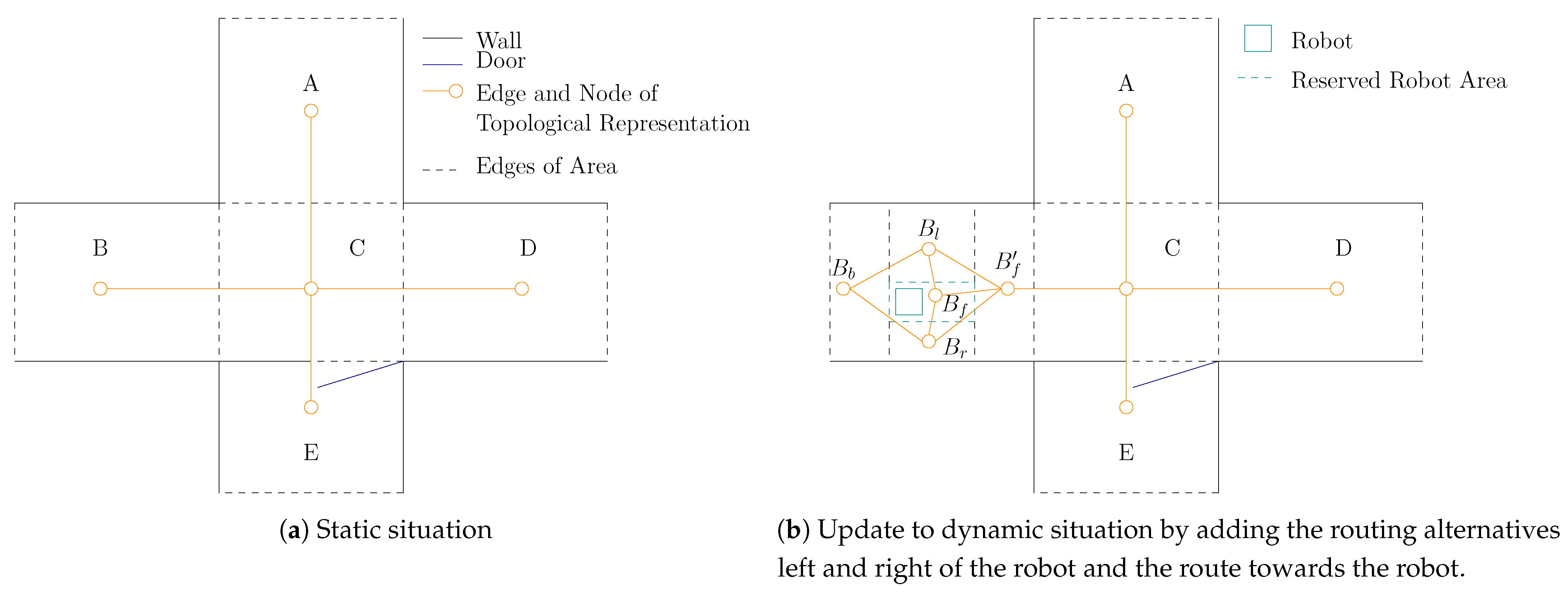

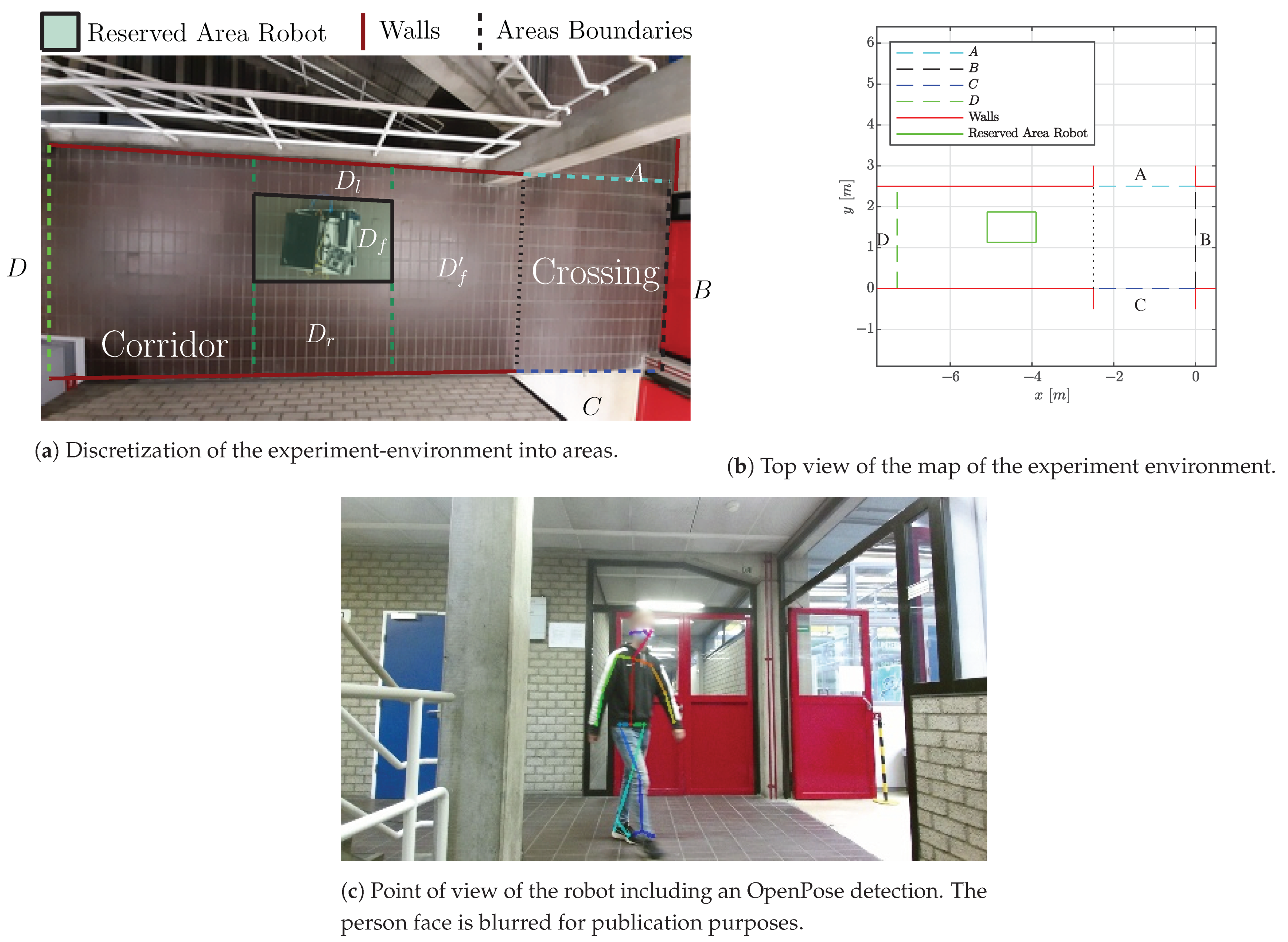

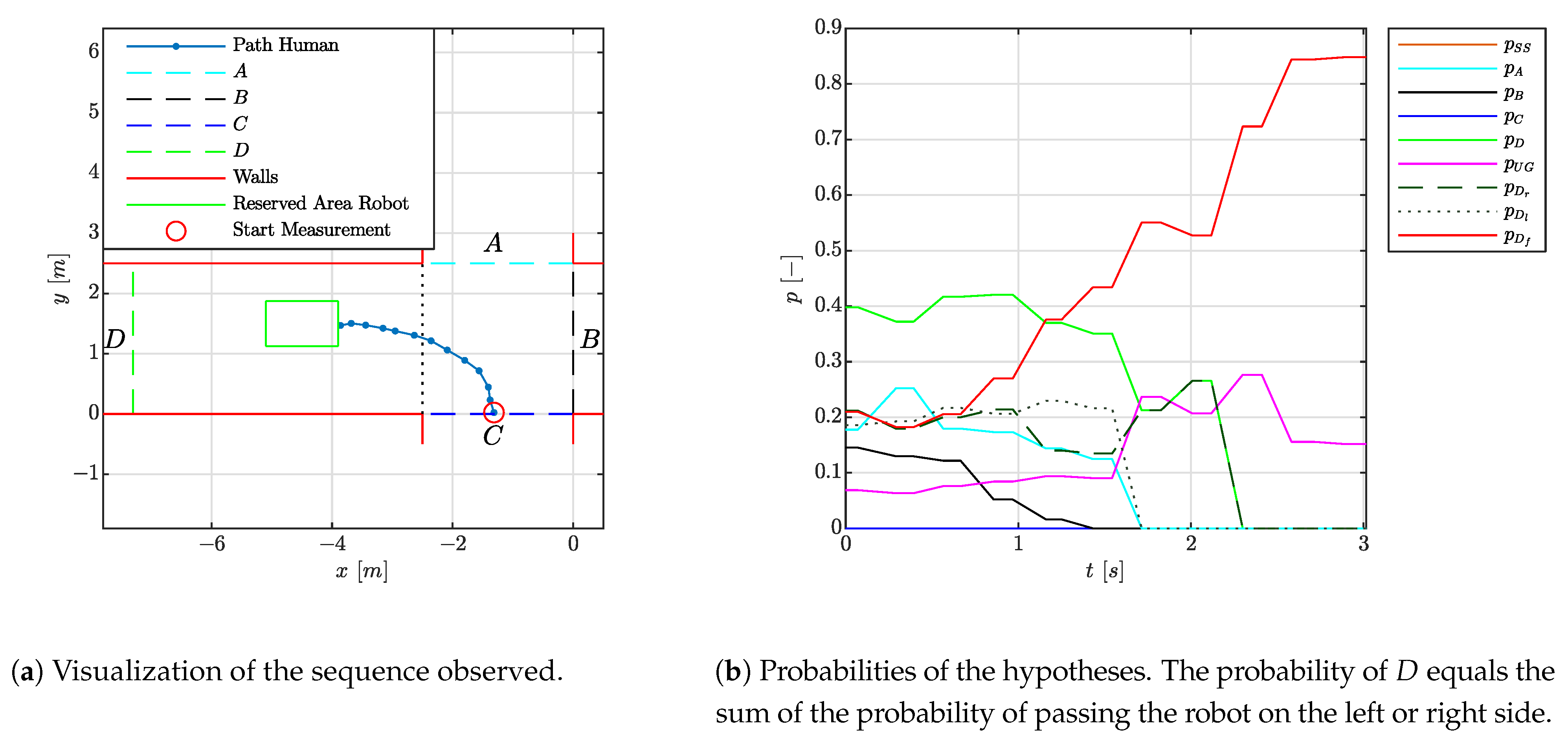

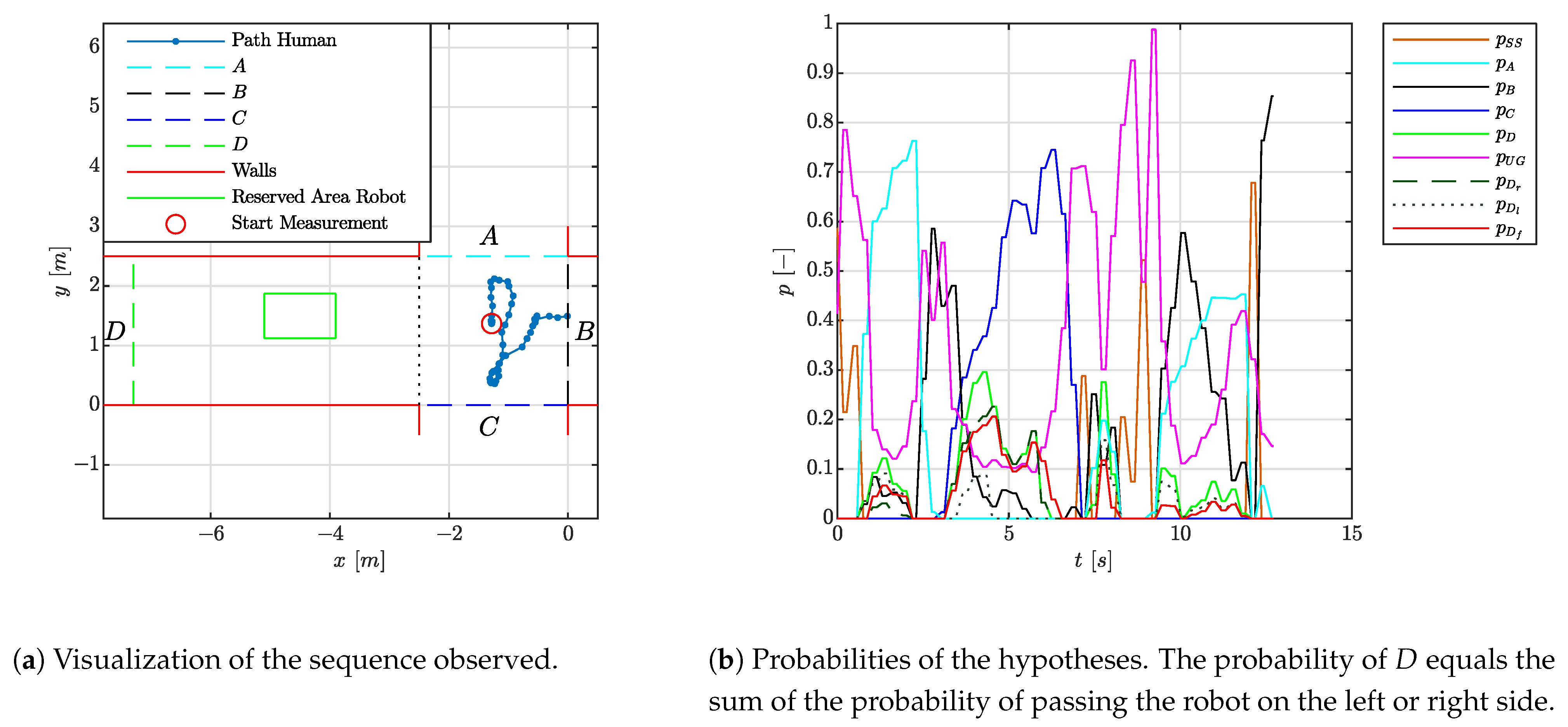
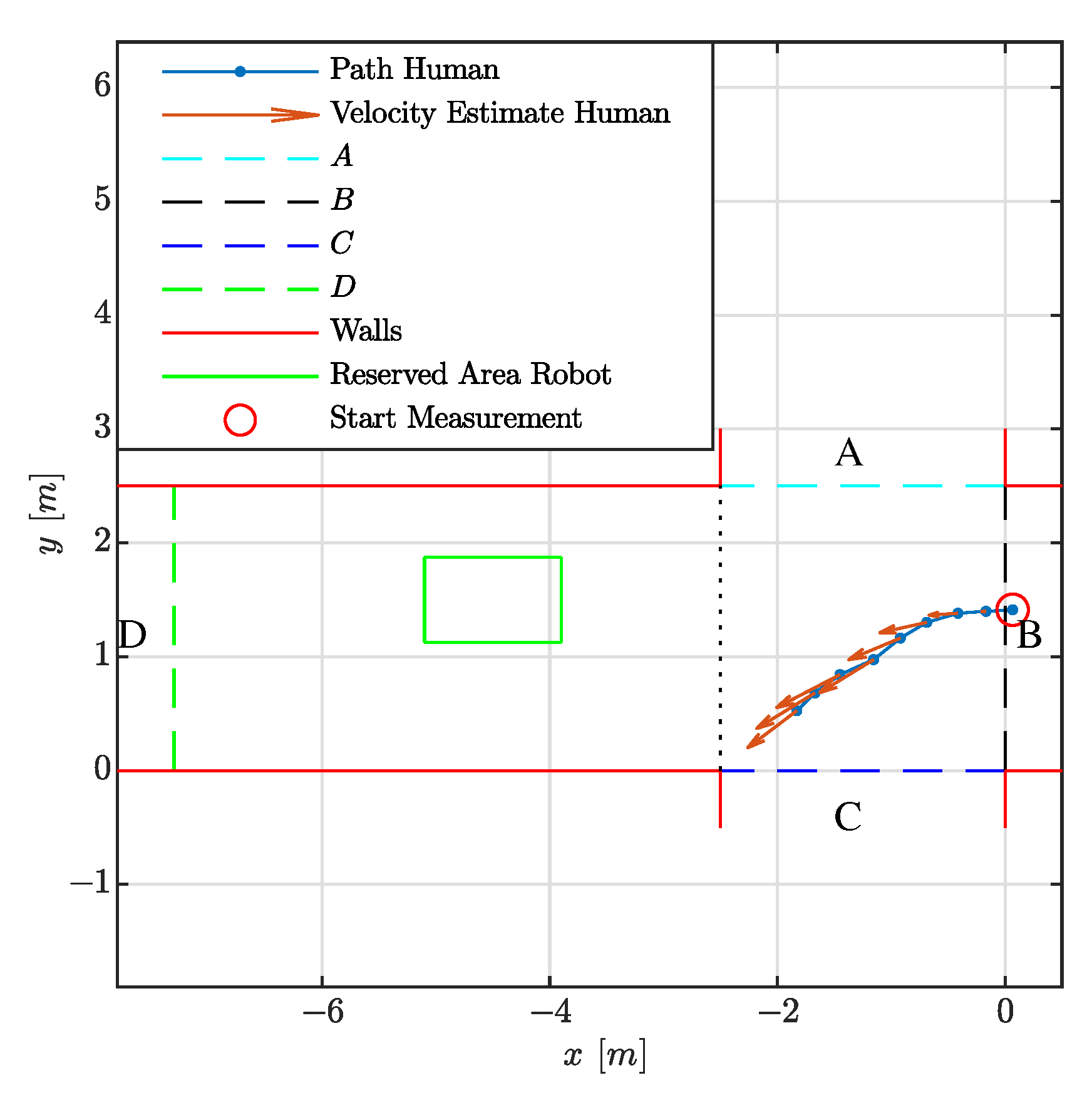

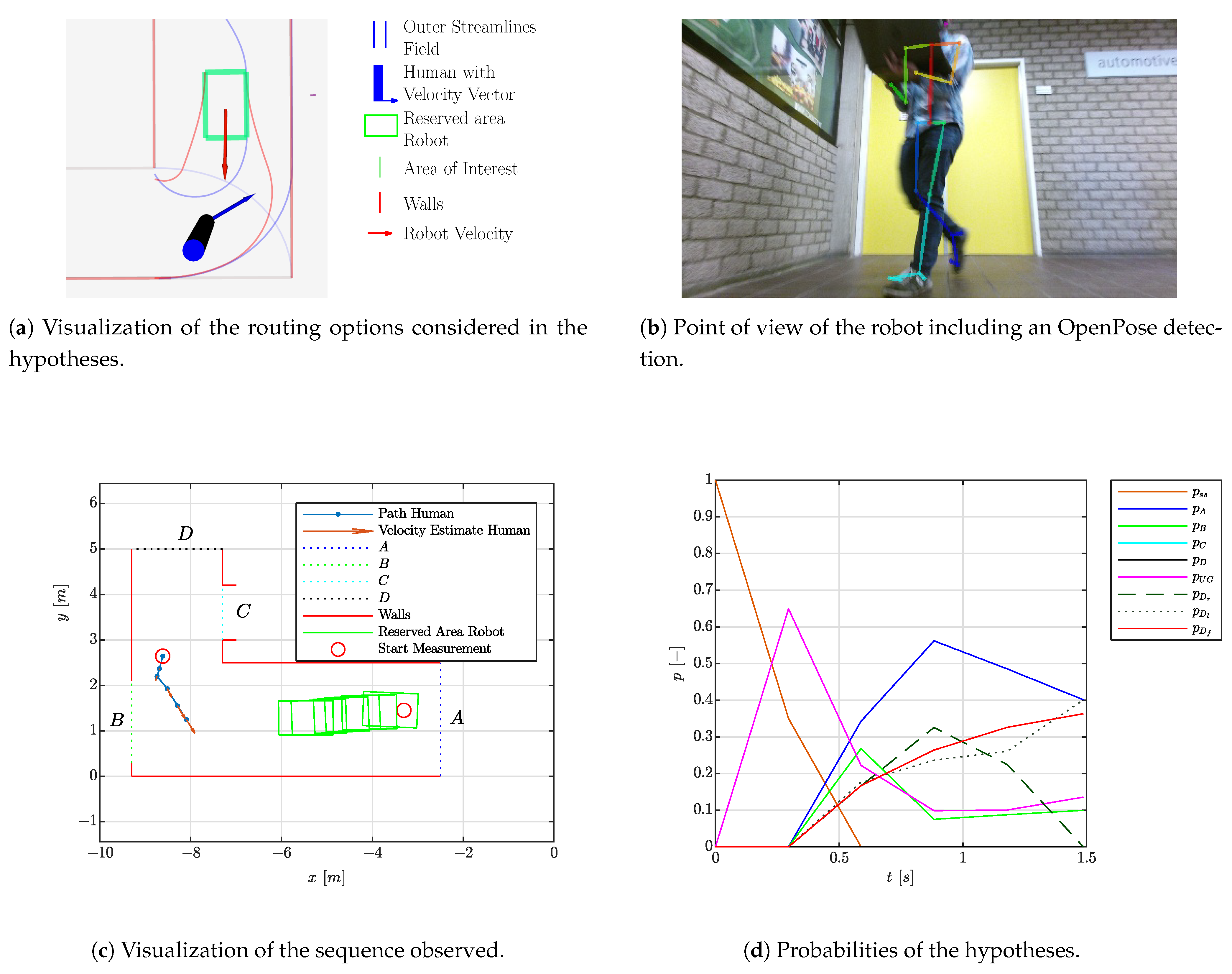
| Hypotheses | Notation | Alternatives Considered |
|---|---|---|
| 1 | All turns k on a crossing | |
| Passing the robot on the left or right side | ||
| Robot is a goal | ||
| 3 | Standstill | |
| 4 | Other goal |
| Setting | Value |
|---|---|
| (length, width) of reserved area robot | () [m] |
| search area around (robot, human) | [m] |
| likelihood | [-] |
| 0.1 [ms] | |
| [m/s] | |
| [s] |
Publisher’s Note: MDPI stays neutral with regard to jurisdictional claims in published maps and institutional affiliations. |
© 2021 by the authors. Licensee MDPI, Basel, Switzerland. This article is an open access article distributed under the terms and conditions of the Creative Commons Attribution (CC BY) license (https://creativecommons.org/licenses/by/4.0/).
Share and Cite
Houtman, W.; Bijlenga, G.; Torta, E.; Molengraft, R.v.d. A Probabilistic Model for Real-Time Semantic Prediction of Human Motion Intentions from RGBD-Data. Sensors 2021, 21, 4141. https://doi.org/10.3390/s21124141
Houtman W, Bijlenga G, Torta E, Molengraft Rvd. A Probabilistic Model for Real-Time Semantic Prediction of Human Motion Intentions from RGBD-Data. Sensors. 2021; 21(12):4141. https://doi.org/10.3390/s21124141
Chicago/Turabian StyleHoutman, Wouter, Gosse Bijlenga, Elena Torta, and René van de Molengraft. 2021. "A Probabilistic Model for Real-Time Semantic Prediction of Human Motion Intentions from RGBD-Data" Sensors 21, no. 12: 4141. https://doi.org/10.3390/s21124141
APA StyleHoutman, W., Bijlenga, G., Torta, E., & Molengraft, R. v. d. (2021). A Probabilistic Model for Real-Time Semantic Prediction of Human Motion Intentions from RGBD-Data. Sensors, 21(12), 4141. https://doi.org/10.3390/s21124141







